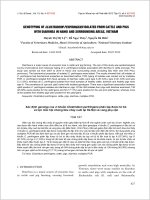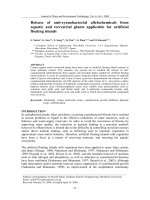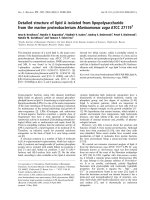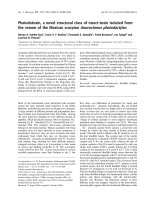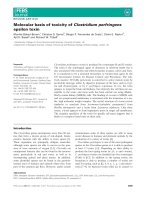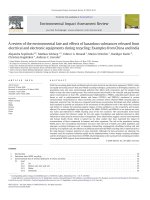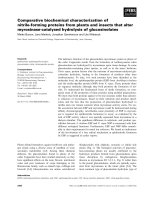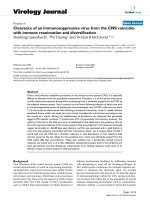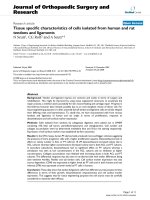GENOTYPING OF CLOSTRIDIUM PERFRINGENS ISOLATED FROM CATTLE AND PIGS WITH DIARRHEA IN HANOI AND SURROUNDING AREAS, VIETNAM
Bạn đang xem bản rút gọn của tài liệu. Xem và tải ngay bản đầy đủ của tài liệu tại đây (246.08 KB, 6 trang )
J. Sci. & Devel., Vol. 10, No. 4: 627-632
Tạp chí Khoa học và Phát triển 2012 Tập 10, số 4: 627-632
www.hua.edu.vn
GENOTYPING OF
CLOSTRIDIUM PERFRINGENS
ISOLATED FROM CATTLE AND PIGS
WITH DIARRHEA IN HANOI AND SURROUNDING AREAS, VIETNAM
Huỳnh Thị Mỹ Lệ
1
*, Đỗ Ngọc Thúy
2
, Nguyễn Bá Hiên
1
1
Faculty of Verterinary Medicine, Hanoi University of Agriculture;
2
National Veterinary Institute
*Email:
Received dat
e: 14.03.2012 Accepted date: 28.07.2012
ABSTRACT
Diarrhea is a major cause of economic loss in cattle and pig farming. The aim of this study was epidemiological
survey of prevalence and molecular typing of C. perfringens isolates associated with diarrhea in cattle and pigs. The
study was carried out from 2007 to 2010 in Hanoi and surrounding areas (including Bac Ninh and Vinh Phuc
provinces). The biochemical properties of isolated C. perfringens were tested. The results showed that: all isolates of
C. perfringens had biochemical properties as described before. PCR typing of isolates was carried out by multiplex
PCR. C. perfringens isolated from fecal samples of diarrheic cattle were type A (57.34%), type D (41.33%) and type
C (1.33%); whereas all C. perfringens isolated from fecal samples of healthy cattle, diarrheic and healthy pigs were
type A. The prevalence of cpe and cpb2 varied with isolated genotypes. There was a significant association between
cpb2 positive C. perfringens isolates and diarrhea in pigs. Of the 304 isolates from pigs with diarrhea examined, 138
(45.39%) were positive for the cpb2 gene and 52 (17.11%) were positive for the cpe and cpb2 genes, whereas none
of the isolates from healthy pigs were positive for the cpb2 gene.
Keyw
ords: Clostridium perfringens, cattle, pigs, diarrhea, multiplex PCR.
Xác định genotyp của vi khuẩn Clostridium perfringens phân lập được từ bò
và lợn mắc hội chứng tiêu chảy nuôi tại Hà Nội và vùng phụ cận
TÓM TẮT
Hiện nay hội chứng tiêu chảy là nguyên nhân gây thiệt hại kinh tế cho ngành chăn nuôi bò và lợn. Nghiên cứu
này được tiến hành nhằm mục đích điều tra tỷ lệ lưu hành, xác định genotype vi khuẩn C. perfringens ở đàn bò và
lợn bị tiêu chảy nuôi tại Hà Nội và vùng phụ cận (Bắc Ninh, Vĩnh Phúc). Kết quả giám định đặc tính sinh hóa cho thấy
vi khuẩn C. perfringens phân lập được mang đầy đủ đặc tính như các tài liệu kinh điển đã mô tả. Sử dụng p
hản ứng
multiplex PCR để xác định định typ và xác định gen mã hóa độc tố của vi khuẩn phân lập được. Kết quả cho thấy vi
khuẩn C. perfringens phân lập được từ bò bị tiêu chảy thuộc ba typ với tỷ lệ lần lượt là typ A (57,34%), typ D
(41,33%) và typ C (1,33%); trong khi đó toàn bộ các chủng phân lập được từ bò khỏe mạnh, từ lợn bị tiêu chảy và
khỏe mạnh đều thuộc typ A. Tỷ lệ mang gen độc tố cpe và cpb2 là khác nhau giữa các typ vi khuẩn phân lập được.
Đặc biệt chỉ các chủng phân lập được từ lợn bị tiêu chảy mới mang gen cpb2, còn các chủng phân lập được từ lợn
khỏe mạnh đều âm tính với gen này; trong số 304 chủng phân lập từ lợn bị tiêu chảy có 138 chủng (45,39%) dương
tính với gen cpb2 và 52 chủng (17,11%) mang cả hai gen mã hóa độc tố cpe và cpb2.
Từ khóa: Clostridium
perfringens, cattle, pigs, diarrhea, multiplex PCR.
1. INTRODUCTION
627
Diarrhea is a major source of economic loss
in cattle and pig farming, causing livestock
growth retardation and even high mortality. In
Vietnam, there were many studies on diarrhea
in cattle and pigs with emphasis on the role of
Escherichia coli (E. coli) and Salmonella;
Genotyping of Clostridium perfringens isolated from cattle and pigs
with diarrhea in Hanoi and surrounding areas, Vietnam
nevertheless, there are few studies on C.
perfringens. Although C. perfringens
enterotoxaemia in cattle has emerged in
Northern provinces since 1997, no effective
prevention program has been put in place. A
study on the role of C. perfringens in
gastrointestinal diseases in domestic animals is
therefore necessary.
C. perfringens is a Gram-positive, spore-
forming, anaerobic bacterium that has long
been recognized as a significant cause of both
histotoxic and gastrointestinal (GI) diseases in
humans and domestic animals (Songer 1996). C.
perfringens strains are classified into five
toxinotypes (A, B, C, D, and E), according to the
production of four major toxins: alpha, beta,
epsilon and iota. Each toxinotype is associated
with a particular disease. Some C. perfringens
isolates (mostly belong to type A) produce C.
perfringens enterotoxin (CPE) and some type
produce the beta2 toxin (CPB2). Several worker
have noted an association of cpb2-positive
strains of C. perfringens type A and the
occurrence of enteric disease in domestic
animals, particular piglets (Klaasen et al., 1999;
Garmory et al., 2000).
The main objective of this study was
epidemiological survey of prevalence and
molecular typing of C. perfringens isolates
associated with diarrhea in cattle and pigs in
Hanoi and surrounding areas. The results could
lead to optimal disease control strategies.
2. MATERIAL AND METHODS
2.1. Fecal samples
Fecal samples from all aged cattle
(diarrheic, n = 128; healthy, n = 42) and 1 - 90
days old pigs (diarrheic, n = 522; healthy, n =
82). Clinical signs of diarrheic animals were
depression, yellowish or grayish diarrhea,
possibly bloody diarrhea, and had a stinking
smell. Fecal samples were collected directly
from the rectum in sterile plastic bags and
transported to the laboratory within 2 - 8 hours
after collection.
2.2. Isolation and confirmation of C.
perfringens
Samples were cultured on Thioglycollate
(TGC) (Oxoid) and incubated anaerobically at
37
0
C for 24 hours. A loop full from overnight TGC
was subsequently cultured onto Clostridium
welchii agar (CW) plates with 4% egg yolk
emulsion (Nissui Ltd.) and incubated
anaerobically at 37
0
C. The plates were read after
24 to 48 hours from growth of C. perfringens.
Typical colonies were identified by characteristic
colony morphology, lecithinase activity on CW,
hemolysis on blood agar, Gram staining, reverse
CAMP reaction and other biochemical tests.
Toxicity of C. perfringens isolated was evaluated
for the presence of lethal toxin by intravenous
injection in mice. Typing of C. perfringens isolates
were determined by multiplex PCR.
2.3. DNA extraction
Four to five colonies of C. perfringens
grown on a blood agar plate were suspended in
200 µl of distilled water and the mixture then
placed in boiling water bath for 15 min for cell
lyses, following by 10 min in ice. The pellets
were removed by centrifugation at 12.000 × g
for 10 min, and the supernatant was used as the
DNA template for PCR.
2.4. Primer and multiplex PCR
Specific primers design were based upon the
sequence of each target genes as published by
Songer and Bueschel (1999) and were
synthesized commercially (Invitrogen) (Table 1).
628
PCR am
plification: the multiplex PCR was
performed in a MasterCycler Thermalcycler
(Eppendorf). Total reaction volume of 25 µl
containing 5 µl of 10 × PCR buffer (Advanced
Biotechnologies), with 750 mM Tris - HCl (pH =
8,) 200 mM (NH
4
)
2
SO
4
; 0,1% (v/v) Tween 20,
dNTPs, 2 mM MgCl
2
(Fermentas); 1 µl of each
primer (10 pmol/µl); 0,1 µl (500 UI/ µl) of Tag
DNA polymerase (Advanced Biotechnologies)
and 2 µl of DNA template. Amplification was
obtained with a program composed of 5 min at
94
0
C, 40 cycles consisting of 1 min at 94
0
C, 1
min at 50
0
C, 1 min at 72
0
C, and a final
incubation for 7 min at 72
0
C.
Huỳnh Thị Mỹ Lệ, Đỗ Ngọc Thúy, Nguyễn Bá Hiên
Table 1. Nucleotide sequences of primers
Primers Nucleotide sequences (5’ - 3’) Size (bp)
cpa (alpha toxin) 5’-GCTAATGTTACTGCCGTTGA-3’
5’-CCTCTGATACATCGTGTAAG-3’
324 bp
cpb (beta toxin) 5’-GCGAATATGCTGAATCATCTA-3’
5’-GCAGGAACATTAGTATATCTTC-3’
196 bp
etx (epsilon toxin) 5’-GCGGTGATATCCATCTATTC-3’
5’-CCACTTACTTGTCCTACTAAC-3’
655 bp
iA (iota toxin) 5’-ACTACTCTCAGACAAGACAG-3’
5’-CTTTCCTTCTATTACTATACG-3’
446 bp
cpe (enterotoxin) 5’-GGAGATGGTTGGATATTAGG-3’
5’-GGACCAGCAGTTGTAGATA-3’
233 bp
cpb2 (beta2 toxin) 5’-AGATTTTAAATATGATCCTAACC-3’
5’-CAATACCCTTCACCAAATACTC-3’
567 bp
The results were examined by
electrophoresis in a 2% agarose gel (Seakem
GTG) for 30 min at 50V and straining with
ethidium bromide. PCR marker was 100 bp
DNA Ladder (Invirogen). Amplified bands were
visualized and photographed by Gel Doc 2000
(BioRad). Positive strains were C. perfringens
NCTC 8239 (type A,) C. perfringens NCTC 6121
(type B,) and C. perfringens NCTC 8346 (type
C.) Negative strain was C. difficle ATCC 43593.
Data were analyzed by Chi-square test
(Minitab 14.0 software) and Fisher Exact Test
(SAS 8.1 software).
3. RESULTS AND DISCUSSION
3.1. Prevalence of C. perfringens
Prevalence of C. perfringens isolated from
fecal samples were shown in Table 2.
Prevalence rates of identified C. perfringens
in fecal samples of diarrheic animals were
significantly higher than of samples from
healthy ones (P < 0.05). There were no
differences among the prevalence of identified
C. perfringens in samples collected from studied
regions (P > 0.05).
The characteristic of the isolates were
positive fermentation of glucose, lactose,
saccharose, maltose, and mannose; a double-
zone hemolysis around the colonies on blood
agar; hydrolysis of gelatin; production of
lecithinase; and a positive reverse CAMP test
result. Also, H
2
S production properties of
isolates from cattle and pigs with and without
diarrhea were 85.33%, 86.67%, 82.89%, and
66.67%, respectively.
Table 2. Prevalence of C. perfringens
Species Clinical signs No of examined samples Positive (n, %) Negative (n, %)
Diarrhea 128
75
(58.59)
53
(41.41)
Cattle
Healthy 42
15
(35.71)
27
(64.29)
Diarrhea 522
304
(58.24)
218
(41.76)
Pigs
Healthy 82
21
(25.61)
61
(74.39)
629
No = number
Genotyping of Clostridium perfringens isolated from cattle and pigs
with diarrhea in Hanoi and surrounding areas, Vietnam
3.2. Genotyping of C. perfringens
The PCR assay was performed on all C.
perfringens isolates. Of the 75 C. perfringens
isolates from diarrheic cattle, 57.34%, 41.33%,
and 1.33% belonged to type A, type D, and type
C, respectively; whereas all C. perfringens
isolated from fecal samples of healthy cattle,
diarrheic and healthy pigs were type A.
As reported in the previous studies, all C.
perfringens isolates from cattle belonged to type
A (Le Lap et al., 2007; Nguyen Quang Tinh,
2008). This was the first time C. perfringens
type D and type C being isolated from cattle in
Vietnam. Because the distribution of C.
perfringens toxinotypes varied in different
geographical areas (Yoo et al., 1997), this result
would be very useful for epidemiological studies,
prophylaxis programs, and the design of
strategies for correct use of C. perfringens
vaccines in Vietnam.
3.3. Prevalence of cpe and cpb2 positive
isolates
In this study, all isolates C. perfringens
were analysed by multiplex PCR to determine
the toxicity of C. perfringens isolates and the
correlation between diarrhea in animals and the
presence of cpe and cpb2 genes positive C.
perfringens. The results were shown in Table 3.
86.66% out of 15 C. perfringens isolates
from healthy cattle were cpe- and cpb2-. This
prevalence was significantly higher than that of
isolates from diarrheic cattle (P < 0.05.) All cpe
gene positive C. perfringens isolates were
originated from diarrheic cattle. The percentage
of cpb2 and both cpe / cpb2 genes positive C.
perfringens isolated from diarrheic pigs were
45.39% and 17.11%, respectively. There were no
cpb2 positive isolates from healthy pigs. Along
with the major toxin, enterotoxin and beta2 play
the major role in several diseases (Songer, 1996;
Gibert et al., 1997; Petit et al., 1999.) The beta2
toxin was first purified from C. perfringens type
C strain CWC245, which was isolated from a
piglet that died of necrotizing enterocolitis
(Gibert et al., 1997) and has been associated
with enteric diseases in domestic animals
(Gurjar et al., 2008.) Enterotoxin is considered a
virulence attribution in animal strains of C.
perfringens (Meer and Songer, 1997.)
Table 3. Prevalence of cpe and cpb2 positive C. perfringens types
isolated from fecal samples
Species Type Isolate source
cpe
+
(n, %)
cpb2
+
(n, %)
cpe
+
and cpb2
+
(n, %)
cpe
-
and cpb2
-
(n, %)
Diarrhea
(n = 43)
9
(20.93)
15
(34.88)
6
(13.95)
13
(30.23)
A
Healthy
(n = 15)
1
(6.67)
1
(6.67)
13
(86.66)
D
Diarrhea
(n = 31)
12
(38.71)
1
(3.23)
18
(58.06)
Cattle
C
Diarrhea
(n = 1)
1
(100)
Diarrhea
(n = 304)
67
(22.04)
138
(45.39)
52
(17.11)
47
(15.46)
Pigs A
Healthy
(n = 21)
5
(23.81)
16
(76.19)
630
+ : positive; - : negative
Huỳnh Thị Mỹ Lệ, Đỗ Ngọc Thúy, Nguyễn Bá Hiên
The enterotoxigenic strains of C. perfringens
were found in cattle and horse isolates
(Tschirdewahn et al., 1991.) Enterotoxin is most
often produced by type A, but it may be produced
by all of other C. perfringens types.
Enterotoxigenic C. perfringens type A strains
cause outbreaks of food poisoning in humans
(Kalender et al., 2005).
The prevalence of cpe and cpb2 genes
negative isolates out of C. perfringens isolates
originated from healthy cattle was significantly
higher than that of isolates from diarrheic cattle
(P < 0.05), meaning C. perfringens had changed
in toxicity and would become one of the
hazardous agents causing diarrhea.
Although in this study, the role of
enterotoxin was not confirmed in C. perfringens
infections of cattle, the study result may reveal
a warning of the risk of source of CPE+ C.
perfringens, which can lead to outbreaks of food
poisoning in the studied areas.
The most important finding in this study is
the detection of cpb2 positive C. perfringens
isolates in cases of diarrhea only, and not in
healthy pigs, corroborating the results of others
(Bueschel et al, 2003; Das et al, 2009; Klaasen et
al, 1999.) This finding suggested that C.
perfringens type A isolates carrying an additional
cpb2 gene might play an important role in causing
diarrhea in pigs in Hanoi, Vietnam.
4. CONCLUSION
In conclusion, prevalence rates of identified
C. perfringens in fecal samples of diarrheic
animals were significantly higher than of
samples from healthy ones (P < 0.05.) We
demonstrated for the first time that C.
perfringens type A, C and D isolated from
diarrheic cattle in Vietnam. In addition, the
finding that cpb2 gene positive C. perfringens
type A might play a role in causing diarrhea in
pigs could help the development of vaccines to
protect against the effects of the β2 toxin in pigs
in Hanoi, Vietnam.
Acknowledgments
This research is part of PhD work of the
first author and was carried out in collaboration
between Dept. of Vet. Microbiology and
Infectious Diseases, Vet. Medicine Faculty,
Hanoi University of Agriculture (HUA) and
Dept. of Microbiology, National Institute of Vet.
Research. The authors thank Dr. Jackques
Mainil and Dr. Annick Linden (University of
Liege) for helpful suggestions and discussions.
We also gratefully acknowledge Vietnam-
Belgium Project of HUA for funding and
providing the facilities to work.
REFERENCES
Lê Lập, Nguyễn Đức Tân, Lê Văn Sơn, Lê Đình Hải,
Đặng Thanh Hiền, Đào Duy Hưng, Trương Công
Thôi, Võ Thành Thìn (2007). Phân lập và xác định
type độc tố (Toxinotype) của vi khuẩn Clostridium
perfringens ở động vật nhai lại bằng kỹ thuật
Multiplex PCR. Science & Technology Journal of
Agriculture &Rural Development, 07, 49-51 (in
Vietnamese.)
Nguyễn Quang Tính (2008). Xác định một số đặc tính
của Clostridium perfringens phân lập từ dê bị tiêu
chảy ở tỉnh Thái Nguyên và sử dụng autovacxin
phòng bệnh. PhD thesis, National Institute of Vet.
Research, Hà Nội, Vietnam, 107-117 (in
Vietnamese.)
Bueschel Dawn M., B.Hel
en Jost, Stephen J.
Billington, Hien T. Trinh, J. Glenn Songer (2003).
Prevalence of cpb2, encoding beta2 toxin, in
Clostridium perfringens field isolates: correlation
of genotype with phenotype. Veterinary
Microbiology. 94, 121-129.
Das A., Y. Mazumder, B.K. Dutta, A. Kumar and S.
Selvi (2009). Diagnosis of acute diarrhea in pigs
and piglets in Meghalaya, India. Malaysian Journal
of Microbiology. 5 (1), 38-44.
Garmory, H.S., N. Chanter, N.P. French, D. Bueschel,
J.G. Songer, R.W. Titball (2000). Occurrence of
Clostridium perfringens beta2-toxin amongst
animals, determined using genotyping and subtyping
PCR assays. Epidemiol. Infect. 124, 61-67.
Gibert M., C. Jolivet-Raynaud, M.R. Popoff (1997).
Beta2 toxin, a novel toxin produced by Clostridium
perfringens”. Gene. 203 (1), 65-73.
Gurjar AA., N.V. Hegde, B.C. Love, and B.M. Jayarao
(2008). Real-time multiplex PCR assay for rapid
detection and toxintyping of Clostridium perfringens
toxin producing strains in feces of dairy cattle.
Molecular and Cellular Probes. 22 (2), 90-95.
631
Kalend
er H., H.B. Ertas, B. Cetinkaya, A. Muz, N.
Arslan, A. Kilic (2005). Typing of isolates of
Clostridium perfringens from healthy and diseased
sheep by multiplex PCR. Vet. Med. - Czech. 50,
439-442.
